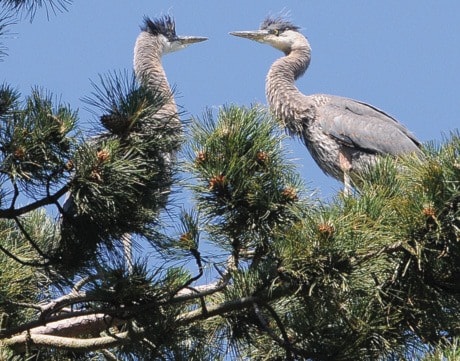Staccato squawking fills the air around Goodacre Lake at Beacon Hill Park.
All the racket is a good sign.
"We're hearing children demanding food, loudly," explains Fred Hook, Victoria's environmental technician.
For the past four years, the city has been keeping a close eye on the number of heron nests in the park. After they almost disappeared in 2009, the number of nests has climbed from 11 to 54 this year. That's almost exactly half the number that were in the park in 2008.
It doesn't take long to spot the endangered species, high in the sequoia trees. Spectators on the stone bridge point out several nest sites, visible only by the large flapping wings of parent herons.
Typically, herons build their nests in lower, more open trees. Hook speculates that this year's switch to the tall bushy sequoias may be motivated by a desire to stay hidden from eagles.
Eagles have been more of a threat in recent years.
In 2008, a long-time resident eagle in the park died. His departure sparked the sudden drop in the herons' population.
The presence of an eagle's nest nearby actually serves to protect the heronry, explained Hook. "When we don't have an eagle nesting in here, then random, marauding eagles come off the shoreline and look for an easy food source."
Herons are primitive birds, he said. "You see that when they fly, they need to do those long swoops … They can't turn quickly in the air, which is one of the reasons the eagles have such an easy time taking their eggs."
This year, there are no new eagles nesting in the park, lowering the chances of success for the 54 heron nests, each with two or three babies.
"As to the long-term success rate, we don't know," Hook said. "We do what we can to protect them, but we can't get up there to chase off predators."
To help out the herons, the city planted 180 native species of fast-growing trees – but these won't be big enough for nesting for another decade.
Next, the city intends to improve its signage to inform dog owners that their pets aren't welcome in the heron rookery, south and west of Goodacre Lake.
Saanich is also working on a plan for its own heron habitat at Cuthbert Holmes Park.
The park has undergone an environmental review and mapped out sensitivity zones, including areas where herons nest, said Rae Roer, manager of parks. That includes limiting activities, maintenance and development in these areas, he said.
rholmen@vicnews.com
